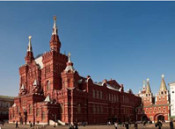
Museums of Russia: "Fame of Russia" permanent exposition of the State Historical Museum opens in Moscow
On November 3, 2014, in Moscow will be held the opening of the permanent exposition of the State Historical Museum entitled "Glory to Russia".
An extensive, most complete collection of artillery weapons, gear and ammunition supplies of XVI-XX centuries is presented in the "Artillery Yard" exposition of the Historical Museum. For the first time an interior space of the Old Mint - a unique complex of buildings designed in XVIII-XIX centuries, will be open for public.
Throughout the long history of the Historical Museum the Artillery collection was only partially shown within the various thematic exhibitions. The new exposition includes Russian made artillery barrels of XVI-XIX centuries, artillery systems of the period of World War II, as well as the samples of ammunition of XIX-XX centuries.
Exhibition space is divided into areas, where the exhibits are thematically grouped in chronological order: "Russian Cannon Business of XVI-XVII centuries", "Gunnery of XVIII-XIX centuries." "Artillery Systems XX century."
Visitors are granted with an access to each exhibit inside of the areas.
Russian cannon deal XVI-XVII centuries is presented with the barrels of Russian production. There are some rare signature barrels built by Russian masters Osip Ivanov, Chariton Ivanov, Marian Osipov, and Timothy in the collection of the Historical Museum. Several barrels are with a state emblem on them - the two-headed eagle.
In addition to Russian designs the XVIII-XIX century’s gunnery is presented with the trophy weapons of Swedish and Turkish manufactures and with ammunition. In particular, the Swedish gun, made in 1684, most likely is a trophy Battle of Poltava.
Domestic artillery of XX century part of collection consists of the samples of most of the known systems of the Great Patriotic War’s period, as well as with one of the large caliber howitzer shell belonging to the times of both world wars.
A multimedia component will become an integral part of the exhibition, complementing the museum objects by modern means of presenting information.

